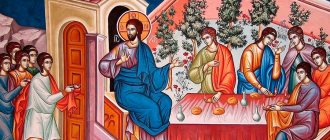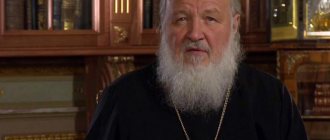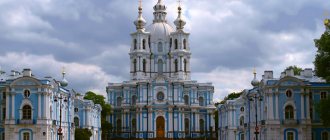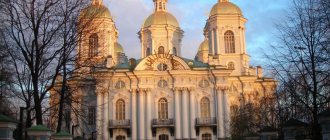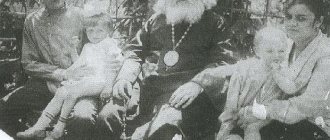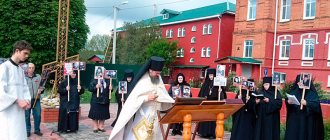| His Eminence | |||||||||||||||||||||||||||||||||||||||||||||||||||
| Bishop Mstislav | |||||||||||||||||||||||||||||||||||||||||||||||||||
| Bishop Mstislav on the day of his consecration. May 22, 2012 | |||||||||||||||||||||||||||||||||||||||||||||||||||
| |||||||||||||||||||||||||||||||||||||||||||||||||||
Biography
Born on November 11, 1967 in the village of Vishnevets, Zbarazh district, Ternopil region. His father, both grandfathers and great-grandfather were clergy. As a child, he helped his father at the altar and baked prosphora. “Under the protection of the Queen of Heaven and Job of Pochaevsky, visiting the Pochaev Lavra, I remember with gratitude my mentors Archpriest Nikolai Myshakovsky and Archimandrite Sylvester and their parting words to my aspiration to be a priest”[1].
After graduating from school, he served in 1985-1987 and came to military service in the village of Chernogolovka. Before his dismissal, he managed to visit the Trinity-Sergius Lavra and venerate the relics of St. Sergius of Radonezh: “the memory of this first visit remained forever in my heart”[1].
He began his service in the Church as a subdeacon of Archbishop of Pskov and Porkhov Vladimir (Kotlyarov)[2]. By my own admission, “After I was accepted by Archbishop Vladimir of Pskov and Porkhov to the position of subdeacon in the Pskov-Pechersky Monastery, in the monastery of the Venerable Martyr Cornelius, I was confirmed in my desire to choose monastic service”[1].
In 1988 he entered the Leningrad Theological Seminary. While studying at the St. Petersburg Theological Seminary, he was a reader at the Holy Trinity Cathedral of the Alexander Nevsky Lavra[2].
In 1992 he graduated from the Leningrad Theological Seminary, after which he entered the St. Petersburg Theological Academy, after which in 1996 he was appointed head of the chancellery of the St. Petersburg diocese.
On March 26, 1998, he took monastic vows with the name Mstislav in honor of the blessed Prince Mstislav in the holy baptism of George the Brave of Novgorod.
On April 12, 1998, Metropolitan Vladimir of St. Petersburg and Ladoga was ordained a hierodeacon, and on December 4, 1998, a hieromonk[3].
On July 19, 1999, by decision of the Holy Synod, he was appointed rector of the Konevsky Nativity of the Mother of God Monastery[4]. On October 6, 2001, by decision of the Holy Synod, he was relieved of his post as rector of the Nativity of the Virgin Mary Konevsky Monastery for health reasons[5].
He was a full-time priest of the St. Nicholas Cathedral, rector of the Alexander Nevsky Church in the Constitutional Court.
On April 3, 2007, on the occasion of Easter, he was awarded the rank of abbot[6].
Since 2007 - Secretary of the Diocesan Administration.
On October 28, 2011, by decree of Metropolitan Vladimir of St. Petersburg and Ladoga, he was appointed dean of the Lodeynopol district of the St. Petersburg diocese and acting rector of the Alexander-Svirsky Monastery, while retaining the position of secretary of the diocese. These positions became vacant due to the consecration of Archimandrite Lucian (Kutsenko) who previously occupied them[2].
Bishopric
at the Annual Act of SPbDA.
On October 9, 2013, on March 16, 2012, by resolution of the Holy Synod, he was appointed rector of the Alexander-Svirsk monastery and appointed Bishop of Lodeynopol, vicar of the St. Petersburg diocese[7].
On April 1 of the same year, in the Church of the Kazan Icon of the Mother of God in Vyritsa, Gatchina district, Leningrad region, Metropolitan Vladimir (Kotlyarov) elevated him to the rank of archimandrite and presented him with the abbot’s staff[8].
On April 23, 2012, in the Church of All Saints, Those Who Shone in the Land of Russia, the Patriarchal and Synodal Residence in the Danilov Monastery, he was named bishop[9].
On May 22, 2012, in the upper church in honor of the Epiphany of the St. Petersburg St. Nicholas Naval Cathedral, he was consecrated Bishop of Lodeynopol, vicar of the St. Petersburg diocese. The ordination was performed by Patriarch of Moscow and All Rus' Kirill, Metropolitan of St. Petersburg and Ladoga Vladimir (Kotlyarov), Metropolitan of Eastern America and New York Hilarion (Kapral), Metropolitan of Saransk and Mordovia Barsanuphius (Sudakov), Metropolitan of Volokolamsk Hilarion (Alfeev), Metropolitan Tver and Kashinsky Victor (Oleynik), Archbishop of Berlin-Germany and Great Britain Mark (Arndt), Archbishop of Vilna and Lithuania Innocent (Vasiliev); Archbishop of Sebaste Theodosius (Hannah) (Jerusalem Patriarchate); Bishop of Kashira Job (Smakouz), Bishop of Gatchina Ambrose (Ermakov), Bishop of Peterhof Markell (Vetrov), Bishop of Solnechnogorsk Sergius (Chashin), Bishop of Vyborg Nazariy (Lavrinenko), Bishop of Yeisk German (Kamalov), Bishop of Khanty-Mansiysk and Surgut Pavel ( Fokin), Bishop of Amur and Chegdomyn Nikolai (Ashimov)[10].
From June 11 to June 25, 2012, he took advanced training courses for newly appointed bishops at the All-Church Postgraduate and Doctoral Studies[11].
By the decision of the Holy Synod of March 12, 2013, His Grace Bishop Mstislav was determined to be the Bishop of Tikhvin and Lodeynopol - the ruling bishop of the newly formed diocese, included in the St. Petersburg Metropolis[12].
Since 2021, he has been the rector of the St. Lyudmila Edinoverie parish of St. Petersburg at the courtyard of the Alexander-Svirsky Monastery on the lane. Chelieva, 10, in St. Petersburg[13]
Orthodox Life
On the morning of September 8, 2021, in the city of Luga, Leningrad Region, “in old age, full of days” (Job 42:17), at the 83rd year of his life, Hieroschemamonk Valerian (Dyachina), the father of Bishop Mstislav of Tikhvin and Lodeynopol, who served God for 55 years, reposed in in holy rank at the throne. For more than thirty years, Father Valerian stayed in Western Ukraine: he was the rector of the Archangel Michael stone church in the village of Belozirka, Lanovets district, Ternopil region, served as rector of the Church of the Nativity of the Blessed Virgin Mary on Tuniki in Kremenets and the dean of the churches of the Kremenets region of the Lviv-Ternopil diocese.
Father Hieroschemamonk Valerian was born in 1935 in the village of Bodaki, in Volyn, 25 km from the Pochaev Lavra, into the family of Theodora and Nikanor Dyachin. The third child was named Valerian, in honor of the martyr whose memory was celebrated on this day. The boy was lucky; he grew up in a church-going family, where Orthodox traditions were revered and strictly observed. The parents' house was located 100 m from the Church of St. Nicholas the Wonderworker.
Mom, Feodora Grigorievna, graduated from a parochial school, and was one of the first students, since previously only boys studied in such institutions. The Lord gave her a wonderful voice, and at the age of eight she sang in the church choir. Her voice was so pure that at the district review of church choirs she was awarded first place as a soloist. And as a gift, she was presented with the Gospel, which she had read since childhood and which became a guide in her life and in the life of her son, the future priest Valerian. Feodora Grigorievna sang in the choir until she was 82 years old. The Lord gave her a long life; she lived 95 years.
Father, Nikanor Vasilyevich, was born in 1893, went through the First World War, and was awarded the St. George Cross. He worked in agriculture. He died when he was 62 years old. Nikanor Vasilievich himself did not serve in the church, but his father, Vasily Damianovich, was a church warden for 25 years.
In addition to Valerian, the family had two older brothers, Leonid and Vladimir, and a younger sister Maria. However, for some reason, it was the youngest son Valerian that the parents took with them when they went to Pochaev on a pilgrimage to the Lavra. And one day the father said to his son: “You will be a priest.” Then the young man did not attach any importance to these words. And they turned out to be prophetic.
Pochaev Lavra. Father Valerian (in the center) with the brethren of the monastery and youths - the future bishops of our Church. 1978
The family lived modestly but amicably. Everyone knew their responsibilities around the house and housework. The love of work was instilled in children from an early age. The children helped their parents, studied, drew, glued Christmas tree decorations and, of course, visited the temple.
The years of school were coming to an end, and the young man was faced with the question of how to live further. He had good literary abilities, and his soul was drawn to the temple. The decision was made finally and irrevocably: to give my life to serve the Lord and people. Father Valerian also told this fact. After the last graduation lesson, he and his classmates went to the river, sat on the grass and decided to take turns telling each other who wanted to become who. “I will become an artist, and I will be a military man...” - the boys revealed their secrets; Valerian was the last to say: “I will be a priest.” This statement stunned everyone. “How, at a time like this when churches are closed?! Maybe you'll change your mind? - friends persuaded. “No, I won’t change my mind,” came the firm answer.
After graduating from school, Valerian, like everyone else, was drafted into the Soviet army, where he served conscientiously for three years. They offered to stay and continue their military career. But a young man who had already devoted himself to serving God, like his uncle John Dyachina, who in the 1930s became a priest in distant Canada and served for many years (more than 40 years) in the American Metropolis, and from March 9, 1941 until his death on 17 January 1976 was the rector of the significant Cathedral of Christ the Savior in Toronto, and the Leningrad Theological Seminary was waiting. He entered the seminary, despite serious competition, immediately after demobilization. During his admission, Valerian met seminarian Sergius Buchkovsky, the brother of his future mother. After graduating from the third grade of the seminary in 1961, he married Taisiya, whom he treated with great tenderness and respect.
In the fourth grade of the seminary, Valerian served as a deacon at the academic church of St. ap. and ev. John the Theologian. The ordination to the rank of deacon took place on October 9, 1961, on the patronal feast of the academic church. And upon completion of his studies, on June 6, 1962, he was ordained a priest by Metropolitan Pimen (the future patriarch) in the Trinity Cathedral of the Alexander Nevsky Lavra.
During his four-year study at the theological academy, Father Valerian served as a priest in the academic church. The daily routine was quite intense. The seminarians got up at seven o'clock in the morning, the priest serving the Liturgy at about 5 o'clock in the morning. Then - morning prayer, breakfast in the dining room, classes, lunch, free time from 15 to 17 hours, after which - preparation for classes. Sleep at 11 o'clock. It was not difficult for Father Valerian to get used to this routine; the army habit of the regime was preserved. In 1962, Mother Taisiya gave birth to a daughter. The girl was named Sofia. While the priest was studying in Leningrad, mother and daughter lived in Ukraine with their parents.
After the Liturgy service. Meadows
Having defended his dissertation written at the Theological Academy on the topic “The Gospel - as the basis of morality for a Christian,” Father Valerian received the degree of candidate of theology. He particularly recalled his years of study at the Theological Academy, because four bishops graduated from his course. One graduate remained to teach at the academy, another became rector of the Vladimir Cathedral in Leningrad, a third in Lomonosov, and another in Moscow.
In 1966, Father Valerian graduated from the Theological Academy and, with the direction of the Educational Committee of the Moscow Patriarchate, returned home. In 1967, his son Mikhail was born, now the Bishop of Tikhvin and Lodeynopol.
In the office of the Lviv diocese, Father Valerian was offered a very good option for ministry: the resort town of Zalischiki in Ukraine. But the promise given to Mother Taisiya’s parents before their marriage (to all live under one roof and to bury the elderly in their homeland) left him no choice. And he became a priest in the village of Belozerka, Lanovets district in the Volyn part of the Ternopil region, 60 km from the regional center, where he served humbly, avoiding the spirit of lust for power and careerism. The village is large, up to 1000 houses. The young priest became the rector of the Church of the Archangel Michael. Then he and his employees were the first in the region to repair the temple. The priest served in Belozerka for nine and a half years, after which, by Decree of Metropolitan Nikolai (Yurika) of Lvov and Ternopil, he was appointed dean of the churches of the Kremenets district, where the famous Pochaev Lavra is located, and transferred to serve in the city of Kremenets.
Located 25 km from Pochaev, Kremenets had a population of 33 thousand people. Father Valerian served as an assistant to Dean Sergius Karinkovsky, who was old and sick. And three months later he was appointed rector of the Church of the Nativity of the Virgin Mary and dean of the district. Serving as rector of the city parish on Tuniki in Kremenets, he brought the temple into an exemplary form: beautiful splendor and perfect order. As a kind owner, he took care of the welfare of all the churches in the region, which he visited on patronal feast days. Having a theological education, Father Valerian, who preached wonderfully himself, tried to raise the level of preaching in parishes. He especially, like a good father, cared about the deanery among the clergy and the high level of spiritual life of the clergy.
Meadows. At the consecration of the throne
The family lived in Kremenets for 25 years. On March 31, 1972, Metropolitan Nicholas, with the blessing of His Holiness Pimen, Patriarch of Moscow and All Rus', Father Valerian was awarded the rank of archpriest. They lived modestly, but paid great attention to the upbringing and education of their children. The daughter and son attended music school. For eleven years, until 1988, the priest served as dean of the city of Kremenets and the region, this is a great merit of Mother Taisia. There was a lot of work, sometimes there was not enough time for everything. After all, there were more than 30 parishes in the deanery. Father Valerian stood at the origins of the revival in Kremenets at the St. Nicholas Cathedral of the Regency Courses, which soon became the Regency Theological School - a structural subdivision of the Pochaev Theological Seminary.
In 1992, Father Valerian was appointed teacher of the Holy Scriptures of the New Testament for choir choir directors, and two years later he became an inspector of the choir department at the Pochaev Theological Seminary, that is, practically a leader. Father Valerian put his whole soul and heart into the educational process and teaching. Father was also the editor of a local Orthodox newspaper. In 1987 he was awarded the Order of Sergius of Radonezh, 3rd degree. For his work as an inspector of the regency department at the Pochaev Theological Seminary, he received the Order of St. Nestor the Chronicler, and in 1991 he was awarded a miter.
In 2000, Mother Taisiya suffered from a serious illness - a stroke. Father Valerian, seeing how his loved one needed help, was torn between home and service. After the untimely death of his mother and the retirement of the clergy of the Ternopil diocese due to age, in 2000 he moved to the St. Petersburg diocese, where his children served: the eldest daughter Sofia, who, after graduating from the regency department at the LDA, married an academy graduate Nikolai Denisenko from priestly family, who became the rector of churches in Luga and the dean of the Luga district), and the son of abbot Mstislav (in the world Mikhail), now the bishop of Tikhvin and Lodeynopol. While living with his daughter, he constantly helped young clergy during services, and was the confessor of the laity and clergy... It should be noted that his daughter, Mother Sophia, also diligently serves the Church and the Lord with her singing talents. She has led and sung in the church choir for many years. In 1996, Archpriest Valerian Dyachina made the first pilgrimage to the Holy Land and in April 2007 visited Jerusalem for the bright holiday of the Resurrection of Christ and the Holy Fire ceremony.
During a pilgrimage to the Holy Land. Church of the Resurrection. Distribution of antidor
The personality of the blessedly deceased Father Valerian, his pastoral appearance and zealous service left a special mark on the lives of many young men, to whom he gave recommendations for admission to seminaries and ordination to the priesthood. He became a good role model for many future shepherds of our Church. His prayerful spirit and tenderness during service, calm and at the same time majestic voice, true wisdom and prudence, meekness and humility, heartfelt words of preaching forever remained in the souls of those who communicated with him. He was a real educator and loved students, knew how to instruct them in such a way that all his words, well-wishes and comments became unforgettable and brought wonderful fruits for the Church.
Great happiness for a true spiritual shepherd was the fulfillment of his good desire - taking monastic vows, which the Lord honored him with immediately into the Great Angelic Image before the end of his earthly life.
On Sunday, September 10, the day of remembrance of St. Job of Pochaev, whom the deceased shepherd so loved and honored, his funeral service and burial were performed.
The acquaintances and spiritual children of Father Valerian in Ukraine and in many parts of the world pray to the Conqueror of death, our Lord Jesus Christ, that He may rest with the righteous the soul of His faithful servant in a place “where there is no illness, no sorrow, no sighing, but endless life,” and created eternal memory for the Newly Deceased.
Bishop Job (Smakouz)
Notes
- ↑ 123
“We pray for the future of the country and the Church” // Ladya: ethno-confessional almanac of the Leningrad region. 2021. - No. 3 (12). — C. 30 - ↑ 123
News - website of the St. Petersburg Metropolis - Journal of the Moscow Patriarchate No. 8. 2012 Archival copy dated August 13, 2012 on the Wayback Machine
- Definitions of the Holy Synod of June 4 and July 18-19, 1999: Russian Orthodox Church (undefined)
(inaccessible link). Date accessed: April 29, 2021. Archived March 4, 2021. - Journal of the meeting of the Holy Synod of October 6, 2001: Russian Orthodox Church (unspecified)
(inaccessible link). Date accessed: April 29, 2021. Archived January 2, 2021. - Patriarchal awards for the holiday of Holy Easter - website of the St. Petersburg Metropolis
- Journals of the meeting of the Holy Synod of March 15-16, 2012. // Patriarchia.Ru
- Abbot Mstislav (Dyachina), elected Bishop of Lodeynopol, vicar of the St. Petersburg diocese, was elevated to the rank of archimandrite (unspecified)
.
Patriarchia.ru
(April 2, 2012). - The naming of Archimandrite Nil (Sychev) as Bishop of Murom, Archimandrite Mstislav (Dyachina) as Bishop of Lodeynopol and Archimandrite Nikita (Ananyev) as Bishop took place. // Patriarchia.Ru
- On the day of remembrance of St. Nicholas the Wonderworker, His Holiness Patriarch Kirill celebrated the Liturgy at the St. Nicholas Naval Cathedral of the Epiphany in St. Petersburg and presided over the consecration of Archimandrite Mstislav. // Patriarchia.Ru
- Metropolitan Hilarion of Volokolamsk met with teachers and students of St. Petersburg Theological Schools // doctorantura.ru, 2012
Courses for newly ordained bishops have ended at the All-Church Postgraduate School // pravoslavie.ru, June 25, 2012
- Journals of the meeting of the Holy Synod of March 12, 2013. // Patriarchia.Ru
- St. Lyudmila (St. MC. Lyudmila, Prince of Czech) Edinoverie parish of St. Petersburg (forming) at the metochion of the Alexander-Svirsky Monastery Moscow Patriarchate - Rector and clergyman
- SAINTANNA.RU | Cavaliers 2nd degree (undefined)
(inaccessible link). Retrieved November 8, 2021. Archived March 28, 2012. - The best people of the city and region were honored in Tikhvin
- At the end of the second day of the Council of Bishops, awards were given to bishops celebrating memorable dates in 2021 / News / Patriarchy.ru
Prince Mstislav Glebovich in the context of the events of the autumn of 1239
Author - Lupinenko Yuri Mikhailovich
“The dead have no shame…” Prince Svyatoslav 971
The purpose of this article is to reconstruct, based on chronicle and archaeological data, the events associated with the struggle of the inhabitants of Chernigov land with the Mongol-Tatar army in 1239. In particular, the figure of Prince Mstislav Glebovich, his actions during the assault on Chernigov, and the details of the city’s defense are of interest.
In the spring of 1238, having defeated the troops of the Ryazan and Vladimir-Suzdal principalities and devastated their lands, the army of the Mongol-Tatars, which also suffered huge losses, went to rest in the Polovtsian steppes [PSRL, vol. I, stb. 522]. At the beginning of 1239, Batu’s second campaign against Rus' began, as a result of which Pereyaslavl was subjected to blows and destruction in March [PSRL, vol. II, stb. 781 - 782], and in October Chernigov [PSRL, vol. XVI, stb. 51] principality. The Chernigov land was at that time in the possession of Prince Mikhail Vsevolodovich, who was, in addition, the Prince of Kyiv and Galicia [Khrustalev, 2004, p. 171]. Abandoned by their ruler, the townspeople nevertheless offered stubborn resistance to the invaders. In Ipatievskaya [PSRL, vol. II, stb. 782] and Voskresenskaya (addition in square brackets) [PSRL, vol. VII, stb. 144] chronicles describe what happened this way:
“... at the same time, he sent an ambassador to Chernigov, surrounding the city in heavy force; Having heard Mstislav Glebovich attack on the city of foreigners, he came to us with all his warriors [and] who fought them [strongly, fiercely because the battle at Chernigov, they also placed rams on it, and threw one and a half shots at it with stones, and the stone as if 4 men were strong enough to lift him up, but] Mstislav was quickly defeated, and many of his warriors were beaten, and he took the city and set it on fire; She left the bishop alive, and went to Glukhov [and from there to the desert].
In the Nikon Chronicle [PSRL, vol. X, p. 114] slightly different information is reported. This is how stone throwers were used by the defenders of the city: “... and from the city to the Tatars, stones were thrown from the walls in one and a half shootouts...”, Mstislav Glebovich remained alive “and barely escaped”, the name of the captive bishop is called - Perfiry. However, the grandfather of Mstislav Glebovich is named inaccurately. He was the grandson of Svyatoslav Vsevolodovich, and not Svyatoslav Olgovich [Soloviev, 1988, book. I, vol. II, p. 715]. Taking into account reports from various sources, it can be assumed that both sides used sling stone throwers with a counterweight [Kirpichnikov, 1976, p. 72 - 76, fig. 34], throwing stones weighing up to 100 kg. at a distance of up to 300m. (one and a half shootings) [Medvedev, 1966, p. 29].
During the assault, help approached Chernigov, and a field battle was forced on the besiegers. Prince Mstislav Glebovich, who attacked the enemy, does not appear anywhere as the owner of any city, although he apparently was one and came to the rescue of the Chernigovites and Mikhail Vsevolodovich in 1235 [PSRL, vol. II, stb. 772]. Such a prompt response to the situation presupposes the location of Mstislav's inheritance no further than 2 - 3 daily marches of a horse squad (160 - 250 km) [Brix, 2001, p. 383] from the place of the clash. It could be Lyubech, Gomel, Starodub, Novgorod-Seversky. According to the author, the destiny of Mstislav Glebovich was Gomel (the chronicle Gomiy) due to the following justifications.
Gomiy was a significant city in the Chernigov land already in the 12th century. By the beginning of the 13th century. its area was about 50 hectares, which is confirmed by archaeological excavations [Makushnikov, 1994, p. 36]. The city had several defense belts and sufficient human and material resources to conduct an armed struggle, which is confirmed by the events of the 12th century. So in 1142, the Smolensk prince Rostislav Mstislavich “...and went to their volost, and took their entire volost around Gomiya” [PSRL, vol. II, stb. 312], the city, apparently, failed to be taken. In 1158, Izyaslav Davidovich was defeated in the newly flared up struggle for Kyiv and fled to Gomiy, his patrimony. “The Great Prince of Kiev Izyaslav Davidovich, seeing the misfortune and attack on himself, was frightened and trembled, vehemently and wept, and soon ran with his brother with Prince Svyatoslav Davidovich to Vyshegrad in Gomya...” [PSRL, vol.
II, stb. 498, 500]. After some time, the prince assembled his regiments and carried out a victorious campaign into the lands of the Vyatichi, the possession of his enemy Svyatoslav Vsevolodovich, where he captured the city of Oblov.
From the first half of the 11th century. Gomiya was traditionally owned by the Chernigov Olgovichi. In 1164, after the death of Svyatoslav Olgovich, the contender for the Chernigov throne, Svyatoslav Vsevolodovich, sent his governors to the cities of the principality, and what is significant is that he sent his son to Gomiya: “He sent his sons to Gomei, and the posadniks sent ambassadors to the cities” [PSRL, t .II, stb. 523]. Svyatoslav Vsevolodovich had five sons: Vsevolod, Oleg, Gleb, Vladimir, Mstislav [Soloviev, 1988, book. I, vol. II, p. 715]. Perhaps Gomiy was granted to Gleb. From this we can assume that in 1239 Mstislav Glebovich reigned in Gomiya, which he inherited from his father and had sufficient military-economic potential to conduct military operations.
Gomiy and Chernigov were connected by a single road, the chronicle route “to Radimichi” [Kovalenko, Fomin, Shekun, 1992, p. 60], known later as the “Kiev tract” [Shafonsky, 1851, p. 234]. The total length of the route from Gomiya to Chernigov was about 130-150 km. The southern section of the route crossed a serious natural barrier: stretching from west to east at a distance of up to 40 km. Zamglai swamp. It, combined with forests, covered the space from the Dnieper to the middle reaches of the Snov River. In the 10th century along this line ran the border of the Radimichi and Rus' [Shekun, Veremeychik, 1988, p. 93, fig. 1]. This milestone even in the first half of the twentieth century. they crossed only over bridges, artificial dams and a few dry “corridors” [Makushnikau, 1993, p. 54 - 55]. The Zamglai swamp crossed the path “to Radimichi” at the grand-ducal fortress of Zvenichev, which controlled the only dry passage from the Chernigov side.
From a military point of view, the northern volosts of the Chernigov land were an ideal area for secretly concentrating forces and moving them to their starting positions. The Mongol-Tatar army was advancing from the southern direction, and therefore the southern lands were primarily exposed to its influence. The line of the Zamglai swamp could be used by Mstislav Glebovich to hold back the enemy for some time even with insignificant forces, depriving him of the opportunity not only to attack the northern volosts, but even to conduct reconnaissance. The prince had the opportunity to gather all available forces: warriors and warriors from Gomiya, Rechitsa, Chechersk. Mention in the chronicle of warriors, that is, militias [Froyanov, 1980, p. 185 - 215], suggests that the mobilization was simply total. The number of troops assembled by Mstislav can only be speculated. At least three urban centers with courtyards and villages could field 3,000 soldiers. When moving such a large number of cavalry troops, not burdened with convoys, the average speed of its movement was up to 80 km per day [Brix, 2001, p. 383]. By concentrating the army in Gomiya, it was possible to reach Chernigov in 1.5 - 2 days. Taking advantage of the terrain, Mstislav Glebovich reached the attack line without losses, and secretly from the Mongol-Tatars.
The chronicle does not specify the location of the battle between the troops of Mstislav Glebovich and the Mongol-Tatars. It is only clear that it happened not far from Chernigov. Coming out through the Zvenichevsky pass to the approaches (about 30 km) to the city, the Russian army turned out to be an unpleasant surprise for the enemy. Sweeping away the Mongol-Tatar security units, it attacked their main forces engaged in the assault on Chernigov. The “fierce battle..” given by Mstislav’s army and the besieged Chernigovites led by Bishop Perfiry apparently cost the Mongol-Tatars dearly. The Mongols spared the captured bishop and then released him. Only a respected warrior could count on such an attitude. The outcome of the battle was ultimately decided by the enemy's colossal superiority in numbers.
The question arises: what motives and goals did Mstislav Glebovich have? The prince, of course, knew about the strength and equipment of the Mongol army. Russian troops were defeated on the river. Kalka in 1223, near Ryazan in 1237, on the City River in 1238. The Mongol-Tatars took well-fortified cities by storm. Seeing the inaction and indecisiveness of his brother, Grand Duke Mikhail Vsevolodovich, Mstislav decided to act independently in a critical situation. When it came to the siege of the capital Chernigov, he gathered all his available forces and set out on a campaign. Perhaps Mstislav had a plan for joint actions with the defenders of Chernigov, abandoned by their prince. The purpose of the operation could be to inflict the maximum possible losses on the enemy, thus bleeding him dry. It should be borne in mind that Mstislav is a man of his time, brought up in knightly traditions, with his own concept of war, death and honor. Such sentiments were clearly formulated in his speech by Prince Daniil Galitsky: “If a husband is killed in the army, then there is some miracle? Others and houses die without glory, but these ones die with glory! Strengthen your hearts and move your weapons to war!” [PLDR, 1981, p. 290]. The chronicles say nothing about the death of Prince Mstislav Glebovich. The Nikon Chronicle says that the prince “and barely escaped...” [PSRL, vol. X, p. 114]. It can be assumed that Mstislav and part of the army managed to make their way to Gomiy, where they fought their last battle. Archaeological excavations in Gomel have revealed traces of massive fires and destruction in the first half of the 13th century. [Makushnikov, 1994, p. 54], Mongolian arrowheads were discovered (type 66 according to the classification of A.F. Medvedev) [Medvedev, 1966, table. 29, fig. 25 - 26].
1. Brix G. O., 2001. History of cavalry. - M. 2. Kirpichnikov A.N., 1976. Military affairs in Rus' in the XIII - XV centuries. - Leningrad. 3. KovalenkoV. P., Fomin O.V., Shekun O.V., 1992. Ancient Russian Zvenichiv and the belongings of Arab dirhams // Archaeology. No. 1. Kiev. 4. Makushnika A. A., 1993. Rubies of the Gomi Volost in the XII - XIV centuries. (test rekanstruktsyi). // GAS. In memory of Mikhas Tkachov. Part 2. Pn. 5. Makushnikov O. A., 1994. In search of ancient Homius. Gomel. 6. Medvedev A.F., 1966, Hand-held throwing weapons (bow, arrows, crossbow) VIII - XIV centuries. // SAI. Vol. E1 - 36. M. 7. PLDR: XIII century. 1981, M. 8. PSRL, 1997. vol. I - Laurentian Chronicle. M. 9. PSRL, 1998. vol. II - Ipatiev Chronicle. M. 10. PSRL, 2001. Resurrection Chronicle. M. 11. PSRL, 1965. Nikon Chronicle. M. 12. PSRL, 1889. Chronicle of Abraham. SPb. 13. Solovyov S. M., 1988. Works. In 18 books. Book 1. Volume 2. M. 14. Froyanov I. Ya., 1980. Kievan Rus. Essays on social and political history. Leningrad. 15. Khrustalev L. G., 2004. Rus': from invasion to the “yoke”. 30 - 40 years XIII century SPb. 16. Shafonsky A.F., 1851. Topographic description of the Chernigov governorship. Kyiv. 17. Shekun A.V., Veremeychik E.M., 1988. Villages IX - XIV centuries. in the interfluve of the lower reaches of the Desna and Dnieper. // Chernigov and its districts in the 9th - 13th centuries. Kyiv.
Links
- Mstislav, Bishop of Tikhvin and Lodeynopol (Dyachina Mikhail Valerianovich).
| Bishops of Tikhvin and Lodeynopol | ||
| ||
| Bishops of Tikhvin |
| |
